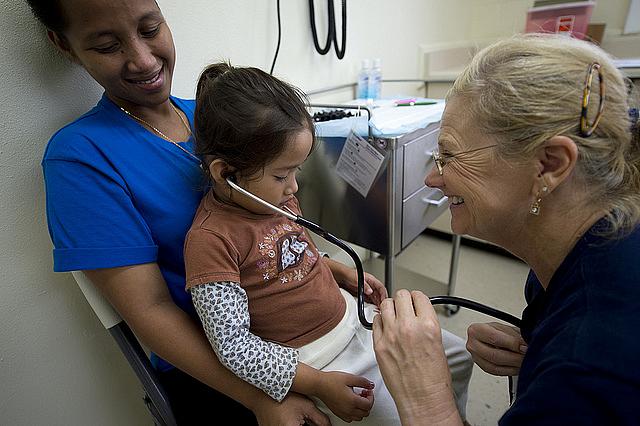Under health reform, ‘patchwork’ pediatric coverage varies widely

Despite the Affordable Care Act’s insurance expansion, children throughout the country are not receiving some important health care benefits. And the extent of these insurance coverage exclusions varies widely depending upon where they live.
Those are some of the findings of a recent study published in Health Affairs that examines the “state-by-state patchwork of coverage with exclusions.”
The Affordable Care Act requires that all health insurance plans sold in the exchanges offer 10 essential benefits including pediatric care. But, other than oral and vision care, the extent of pediatric services isn’t specified. Even though the ACA gave the Health and Human Services Secretary the ability to create a national benefit standard, HHS has instead chosen a state-by-state approach.
States pick a benchmark plan which sets their standard for coverage. As a result, different states offer distinct pediatric benefits for their exchange plans, with some specifically including or excluding services for children with special health needs. Researchers found state-by-state variations in coverage for congenital defects, some autism spectrum disorder treatments, and hearing aids. (The coverage differences aren’t limited to pediatric services, as this recent New York Times article points out.)
The Health Affairs study’s lead author, Aimee M. Grace, a pediatrician and fellow at Children’s National Health System, elaborated on the current system and its effects here:
The Affordable Care Act offers great promise for kids, but we are concerned that its intended benefits are not fully realized for children. We sought to understand which pediatric services are covered, and which ones are excluded, by health insurance plans in the health insurance marketplaces. Since there is currently no national pediatric benefit standard, our analysis compared benchmark plans at the state-by-state level.
Under that landscape of wide geographic variation, where does California fit in? I checked in with Michael Odeh, the associate director of health policy for Children Now, a children’s advocacy group based in Oakland. Overall, California tends to fare well when compared to other states. That’s partly because there were pretty good managed care standards before the ACA, which worked to the state’s advantage, he said.
California’s benchmark plan offers pretty expansive pediatric care benefits, he added. Still, there are some coverage gaps he’d like to see adjusted – such as the exclusion for hearing aids, something that can be especially costly since kids can quickly outgrow them. In comparison, Medi-Cal, the state’s Medicaid program, does cover hearing aids.
With just a year’s worth of data and experiences, it’s still too early to see the full picture.
“Medicaid and CHIP [Children's Health Insurance Program] have a long history of serving children robustly,” Odeh said. Exchanges are unproven when it comes to pediatric care, he added.
In the new year, health leaders are hoping to figure out just how well Covered California is serving the 77,000 children who used its plans in 2014, said Kathleen Hamilton, the director of governmental affairs for The Children’s Partnership, another advocacy group. They’re still not sure to what extent plans are covering children with special health needs, such as Applied Behavior Analysis therapy.
Hamilton said her organization is also working to obtain care utilization data for 2014, including the geographic distribution of care and how many children saw a dentist during that year. They’re also pushing for more parent education, since people who selected Covered California plans for their children might not be aware of exactly which benefits they can receive, she added.
Simply getting the exchange plans to expand pediatric coverage isn’t so simple, though. Rates could go up, affecting the affordability and access of plans.
There’s an inherent tension between a health plan’s desire to offer competitive pricing on Covered California and the need to keep provider contracts limited enough to do so, added Odeh. Narrow networks can be especially challenging for children, whose needs are distinct from adults. Just because a network includes cardiologists doesn’t necessarily mean there are pediatric cardiologists trained to do heart surgery on an infant, he noted.
Covered California plans have improved coverage in some areas in the second open enrollment season, which runs to Feb. 15. In the first year, dental coverage was offered separately from medical coverage, and only about a third of the children with exchange plans enrolled in it, Odeh said. The current enrollment period offers dental coverage that’s embedded within the health plans.
In the future, California children’s health advocates say they’d like to see more detailed definitions of pediatric care in exchange plans; benefit improvements (such as covering hearing aids); and more extensive pediatric networks.
On a national level, the authors of the recent Health Affairs study laid out several recommended policy steps, such as barring pediatric treatment limits and exclusions (particularly on mental retardation) and defining a pediatric benefit standard at the national level. The Department of Health and Human Services has said it plans to review its approach to essential health benefits for the 2016 plan year.
Photo by Naval Surface Warriors via Flickr.
